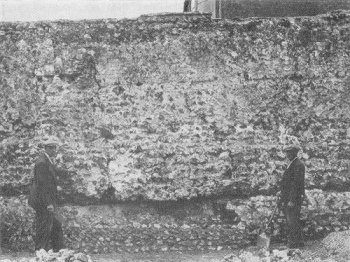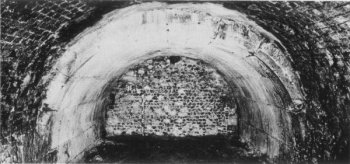The Archaeology of North Walls - Trust Annual Report 1979

North Walls (reproduced by courtesy of the City Museum)
As a result of recent excavations made by the City's Rescue Archaeologist, Mr. Ken Qualmann, it is apparent that the North Walls area between Northgate and Hyde Abbey Road, is of major historical importance. A section through the city ditch in the garden of Northgate House, revealed two phases of the Roman town defences, the first dating from 70AD, and the second area 200AD. The first Roman bank and ditch had no wall, and the subsequent city wall was lost when the city gave a licence to remove the stone. One substantial portion of the Roman wall remains however, near the junction with Hyde Abbey Road (illustrated). The existing flint wall, on the line of the Roman wall, is post mediaeval. The city ditch in the garden of Northgate House was, excavated to a depth of 34 metres, and a second excavation was made on the bank of the bowling green site.
It is apparent that some parts of Northgate itself remain below road level, which has been built up considerably over the years. The mediaeval stone bridge spanning the city ditch, immediately outside Northgate remains in toto (illustrated) and can be inspected. The importance of this and also the remaining Roman defences have been recognised, and application has been made to the Ministry for scheduling as ancient monuments.
Northgate has always been a major means of access to Winchester, and excavations to the north have revealed traces of an iron age road indicating that it was possibly part of the lower defences of the Orams Arbour iron age settlement. There is also evidence of its use during the late Saxon period.

The Bridge at Northgate (reproduced by courtesy of the Winchester Research Unit)
Although no traces of the city wall remain above ground between Hyde Abbey Road and Durngate, there are considerable masonry remains below road level in the Park Avenue area, where the ground level has risen since the mediaeval period. Durngate, which was one of the six major gateways into the city, was situated at the rear of Moorside Garage and is shown on the early ordnance survey. Durngate has never however been excavated, and this must be a potentially important archaeological site, at the north-eastern corner of the city defences.
It is apparent that if North Walls is widened to provide a four lane carriageway, as visualised in the Town Centre Plan, much of great value to the city will be lost. Increasing interest is being taken in the fortifications of walled towns, and suggestions have been made that wherever possible, the line of the walls should be marked in some suitable manner.
(The Trust is indebted to Mr. Ken Qualmann for the information supplied).
